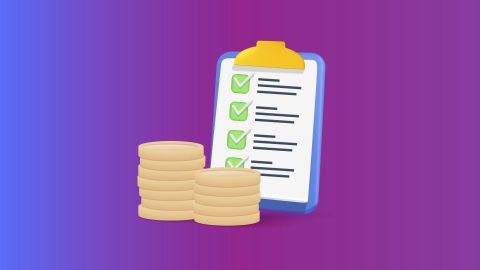What is working capital?
Working capital is a financial metric that indicates the liquidity levels of businesses for managing day-to-day expenses and covers inventory, cash, accounts payable, accounts receivable, and short-term debt. It is an indicator of the short-term financial position of an organisation and is also a measure of its overall efficiency.
Working capital, derived from subtracting current liabilities from current assets, serves as a pivotal financial gauge for companies. It facilitates future planning by ensuring sufficient cash reserves to fulfill immediate obligations like unpaid taxes and short-term debts. Working Capital is a financial metric that reflects a business's liquidity, encompassing vital components such as inventory, cash, accounts receivable, accounts payable, and short-term debt. Not only does it signify the organisation's short-term financial health, but it also acts as a barometer of its operational efficiency.
How to calculate working capital
Working capital = current assets - current liabilities
This calculation indicates whether the company possesses sufficient assets to cover its short-term financial needs.
Positive vs. negative working capital
Positive working capital indicates that a company possesses ample liquid assets like cash and accounts receivable to offset its immediate financial responsibilities, such as accounts payable and short-term debts. This surplus liquidity boosts confidence in meeting obligations promptly and fuels operational stability. Conversely, negative working capital signals a deficiency in current assets to cover short-term financial commitments. Such a scenario poses challenges in honouring supplier payments and may hinder access to funding crucial for business expansion. Continual negative working capital could escalate into operational constraints, potentially leading to business closure if unresolved.
Working capital vs. Fixed assets / capital
Working capital and fixed assets represent distinct components of a company's financial framework. Working capital comprises current assets, characterised by their liquidity, allowing swift conversion into cash. These assets, such as accounts receivable and inventory, facilitate short-term financial obligations. Conversely, fixed assets, including tangible items like real estate and equipment, along with intangibles such as patents, lack the immediacy of liquidation. These assets contribute to a company's long-term operations, enhancing productivity and revenue generation. While working capital ensures short-term liquidity, fixed assets bolster the company's infrastructure and capability for sustained growth and competitiveness in the market.
Sources of working capital
The sources for working capital can be long-term, short-term, or spontaneous. Long-term working capital sources include long-term loans, provision for depreciation, retained profits, debentures, and share capital. Short-term working capital sources include dividend or tax provisions, cash credit, public deposits, and others. Spontaneous working capital comes from trade credit, including notes payable and bills payable.
Types of working capital
There are several types of working capital based on the balance sheet or operating cycle view. A balance sheet view classifies working capital into two types of working capital:
- Net (current liabilities subtracted from current assets featuring in the balance sheet)
- Gross working capital (current assets in the balance sheet)
The operating cycle view classifies working capital into temporary (difference between net working capital and permanent working capital) and permanent (fixed assets) working capital.
Working capital cycle
Working capital cycle refers to the time taken to convert net current liabilities and assets into cash by a business. The shorter the working capital cycle, the swifter the company will free up its blocked cash. Businesses strive to lower this working capital cycle to enhance liquidity in the short term. Bajaj Finserv offers working capital loans to address any deficits in working capital and ensure optimal operations.
Components of working capital
The components of working capital include current assets (such as cash, inventory, accounts receivable), and current liabilities (such as accounts payable, short-term loans, accrued expenses). The current assets are used to finance the company’s short-term expenses, while the current liabilities represent the company’s payments that are due within a year. The working capital ratio (current assets divided by current liabilities) is frequently used to assess a company’s liquidity and its ability to meet its short-term obligations.
Current assets
Current assets are the assets of a company that are expected to be converted into cash or consumed within a year. The most common types of current assets include cash and cash equivalents, accounts receivable, inventory, and short-term investments.
These assets are important because they help the company to fund its daily operations, pay current liabilities, and make necessary investments in the short term. Additionally, a company's ability to manage its current assets efficiently is a critical factor in maintaining its working capital and liquidity.
Current liabilities
Current liabilities refer to the company's obligations that are due within one year or the operating cycle, whichever is longer. Common examples of current liabilities include accounts payable, short-term loans, accrued expenses, and taxes payable.
Managing current liabilities is essential because it impacts the company's working capital, cash flow, and overall financial performance. A company with strong current liability management practices can better finance its short-term obligations, achieve profitability, and create long-term financial stability.
Additional Read: Importance of capital budgeting
Advantages of working capital
There are several advantages to having adequate working capital, including:
- Improved cash flow management, which can help a business meet its financial obligations and avoid cash shortages.
- Ability to meet unexpected expenses, such as unexpected repairs or emergency purchases, without risking the financial stability of the company.
- Ability to take advantage of new business opportunities, such as expanding into new markets or investing in research and development.
- Increased market share and competitiveness, as a business that can meet customer demand consistently is more likely to succeed in its industry.
- Increased flexibility and resilience, as a business with adequate working capital can easily weather economic downturns or unexpected events.
Limitations of working capital
Working capital, while essential for day-to-day operations, has its limitations. One significant constraint is its cyclical nature, fluctuating with sales cycles and operational demands. Insufficient working capital can hinder business operations, leading to liquidity issues, missed opportunities, and strained supplier relationships. Additionally, over-reliance on short-term financing solutions to cover working capital needs may result in higher interest costs and financial risk. Furthermore, ineffective management of working capital can lead to inefficiencies, such as excessive inventory levels or extended accounts receivable periods, impacting profitability and cash flow in the long term. Thus, businesses must carefully manage working capital to mitigate these limitations and ensure sustainable growth.
Examples of working capital
An example of working capital includes the funds a retail store needs to purchase inventory for its shelves. Suppose a store requires ₹10,000 to buy stock for the upcoming holiday season. This ₹10,000 represents the working capital needed to ensure the store has enough goods to meet customer demand. As sales occur, the store can use revenue generated from these sales to replenish its working capital by purchasing more inventory. Working capital is crucial for maintaining smooth operations, ensuring adequate inventory levels, and meeting short-term financial obligations.
Why is working capital important?
Working capital is vital for businesses as it ensures smooth day-to-day operations by covering short-term financial obligations such as payroll, inventory purchases, and utility bills. Sufficient working capital allows businesses to seise growth opportunities, respond to unexpected expenses, and navigate economic downturns. It also enables businesses to maintain healthy cash flow, which is essential for meeting financial obligations and sustaining operations in the long term. Effective management of working capital enhances liquidity, reduces financial risk, and contributes to overall business stability and resilience in dynamic market environments.
What is negative working capital?
Negative working capital occurs when a company's short-term debts are more than their current assets. It means the company's liabilities exceed its ability to pay them, causing financial stress.
This affects businesses significantly, making it difficult for them to pay expenses, such as debts, salaries, or supplier invoices. It also indicates weak cash flow and poor financial management, thereby harming the company's credit score, increasing the risk of bankruptcy, and discouraging investors.
Negative working capital can result from slow-paying customers, excessive inventory, poor cash flow management, or insufficient sales. It may also be a deliberate financial strategy of delaying payments to vendors to conserve capital, which can lead to negative working capital.
Businesses can improve their working capital situation by negotiating payment terms with suppliers, managing inventory levels, facilitating favourable customer collections, and seeking alternative funding methods such as invoice financing or asset-based lending. Regular financial audits also help identify and rectify the underlying causes of negative working capital.
How can a company improve its working capital?
- Optimise inventory management: Reduce excess inventory levels to free up cash and minimise storage costs.
- Accelerate accounts receivable: Incentivise early payments from customers or implement stricter credit policies to shorten the accounts receivable period.
- Extend accounts payable: Negotiate longer payment terms with suppliers to delay cash outflows and preserve working capital.
- Streamline operational efficiency: Identify and eliminate inefficiencies in processes to reduce costs and improve cash flow.
- Monitor cash flow: Regularly track cash flow forecasts and identify areas where cash is tied up unnecessarily.
Does working capital change?
Working capital, for most companies, exhibits continual flux, captured as a snapshot on the balance sheet at a particular date. Numerous factors contribute to its fluctuations, such as significant outgoing payments and seasonal variations in sales. These dynamics affect the quantum of working capital, necessitating agile financial management to adapt to changing circumstances. Whether through investment in inventory during peak seasons or managing accounts payable efficiently, businesses must navigate these shifts to maintain optimal liquidity levels. Such adaptability ensures resilience in operations and facilitates the ability to seize opportunities amid dynamic market conditions.
6 Ways to increase working capital
Improving working capital is essential for businesses grappling with project costs or temporary lows in sales. There are several methodologies that involve fortifying existing assets or minimising liabilities:
- Acquiring long-term loans: This increases cash reserves without significantly burdening liabilities.
- Restructuring short-term debt: By extending payment deadlines, businesses can alleviate immediate financial obligations.
- Liquidating non-cash assets: This transforms non-cash assets into cash, providing immediate liquidity.
- Auditing and cutting down expenses: This practice restricts outgoing capital, thereby reducing liabilities.
- Streamlining inventory management: This strategy prevents excessive stocking and potential product write-offs.
- Digitising receivables: This improves cash flow, reducing the dependency on working capital for everyday operations.
By employing these strategies, businesses can enhance liquidity and effectively navigate financial hurdles.
Bajaj Finserv app for all your financial needs and goals
Trusted by 50 million+ customers in India, Bajaj Finserv App is a one-stop solution for all your financial needs and goals.
You can use the Bajaj Finserv App to:
- Apply for loans online, such as Instant Personal Loan, Home Loan, Business Loan, Gold Loan, and more.
- Invest in fixed deposits and mutual funds on the app.
- Choose from multiple insurance for your health, motor and even pocket insurance, from various insurance providers.
- Pay and manage your bills and recharges using the BBPS platform. Use Bajaj Pay and Bajaj Wallet for quick and simple money transfers and transactions.
- Apply for Insta EMI Card and get a pre-qualified limit on the app. Explore over 1 million products on the app that can be purchased from a partner store on Easy EMIs.
- Shop from over 100+ brand partners that offer a diverse range of products and services.
- Use specialised tools like EMI calculators, SIP Calculators
- Check your credit score, download loan statements and even get quick customer support—all on the app.
Download the Bajaj Finserv App today and experience the convenience of managing your finances on one app.
Frequently asked questions
Working capital is calculated by subtracting current liabilities from current assets. The formula is: working capital = current assets - current liabilities.
Working capital life cycle is the process by which a company manages its working capital, from the initial stage of purchasing raw materials and inventory to the final stage of collecting payments from customers.
Working capital is the difference between a company's current assets and liabilities, indicating its ability to cover short-term obligations. It's crucial for meeting day-to-day expenses and managing cash flow effectively to sustain operations and seise growth opportunities.
The four types of working capital are:
- Permanent working capital: The minimum amount needed for regular operations.
- Variable working capital: Fluctuating capital to manage seasonal demands.
- Gross working capital: Total current assets available for daily operations.
- Net working capital: The difference between current assets and current liabilities.
Working capital is the financial metric representing a company's ability to meet short-term financial obligations. Its primary purpose is to ensure there's enough liquidity to cover day-to-day operational expenses, manage short-term debts, and support ongoing business activities effectively.
Working capital finance refers to the funds that a company borrows to finance its short-term operational needs, such as paying salaries, purchasing inventory, and other expenses. Working capital loans are typically used to address cash flow challenges or unexpected expenses.
Working capital is known as the capital that a company uses or requires to finance its day-to-day operations. It is made up of the company's current assets (such as cash, inventory, and accounts receivable) and current liabilities (such as accounts payable, short-term loans, and accrued expenses). Working capital is essential for a company to continue its operations, maintain its cash flow, and fund its short-term business needs.
To calculate working capital, subtract a company's current liabilities from its current assets. Current assets include cash, accounts receivable, and inventory, while current liabilities include accounts payable and short-term debt.
No, working capital measures a company's liquidity—the ability to cover short-term expenses with current assets. Profit, on the other hand, is the surplus remaining after deducting expenses from revenue.
Working capital turnover is a financial ratio that measures how efficiently a company utilises its working capital to generate sales revenue. It's calculated by dividing net sales by average working capital.
A negative working capital indicates that a company's current liabilities exceed its current assets, potentially signaling liquidity issues. While it's not inherently problematic for all businesses, sustained negative working capital may require financial restructuring or improved cash flow management.









